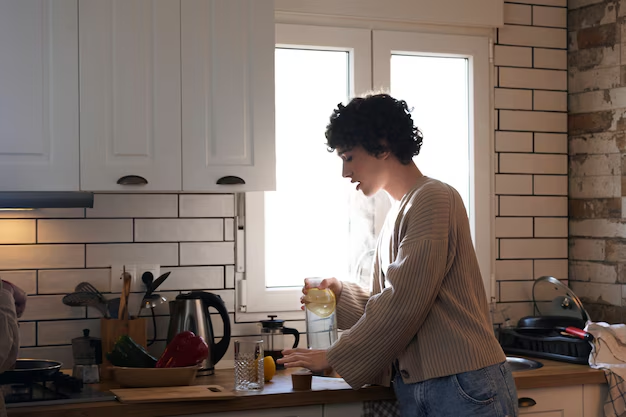Tips and Tricks: How to Secure Your Refrigerator Effectively
A refrigerator lock may not be one of the first items on a new homeowner's list, but it's surprisingly useful. Whether you have curious toddlers, a shared living space, or sensitive items that need safeguarding, understanding how to lock a refrigerator can bring peace of mind and provide the security you need. Let's explore this often-overlooked topic and guide you through ensuring your refrigerator remains secured against unwelcome intrusions.
Why Locking Your Refrigerator Makes Sense
Safety for Children
Keeping children safe is a primary concern for many households. With a refrigerator lock, you can prevent them from accessing potentially dangerous items, like cleaning fluids stored inside or heavy containers that could fall and cause harm.
Reduce Food Theft in Shared Spaces
In houses with multiple families or college dorms, food theft can lead to conflict. A lock helps maintain boundaries and ensures everyone gets what they paid for.
Protecting Valuable or Sensitive Items
If your fridge contains expensive ingredients or sensitive medications that need constant refrigeration, securing it can prevent tampering and potential cost.
Types of Refrigerator Locks
There is no one-size-fits-all solution when it comes to refrigerator locks. Here's a breakdown of some popular types:
Strap Locks
Strap locks are versatile and easy to install. They use a strong adhesive that sticks well to the refrigerator surface and are great for rental properties as they generally don't leave marks.
Cable Locks
Cable locks offer more strength than strap varieties. These locks usually involve a padlock and a durable cable that wraps around the handles of the refrigerator.
Keyed Locks
These locks come with a traditional key mechanism. They are more secure compared to standard strap and cable locks but can be more challenging to install.
Combination Locks
Offering a high degree of security without the need for keys, combination locks require a code to unlock. They are practical in environments where multiple people need access.
DIY Solutions
If you're handy, you can devise your own locking mechanism using standard household materials, such as strong adhesives and padlocks.
How to Choose the Right Refrigerator Lock
With several options available, how do you pick the best lock for your needs? Consider the following factors:
- Security Level: Assess how secure you need your lock to be. For light usage (such as toddler-proofing), strap locks may suffice. For a higher level of security, consider a keyed or combination lock.
- Ease of Installation: If you're not handy or have no time for a complex install, look for locks labeled as "easy install."
- Material Quality: Opt for durable materials that can withstand regular usage.
- Aesthetics: Consider how a lock will look in your kitchen. Some are designed with stylistic neutrality to blend in with most décors.
Installing Refrigerator Locks
Once you've chosen your lock type, knowing how to install it correctly is crucial for effectiveness:
Strap Lock Installation
Clean the Surface: Ensure the refrigerator's surface is clean and dry for the adhesive to stick well.
Position the Lock: Place the lock where it will be most effective, usually at a height beyond young children's reach.
Adhere and Secure: Once stuck, press firmly for a few seconds, allowing the adhesive to bond with the surface.
Cable Lock Installation
Wrap the Cable: Loop the cable tightly around the refrigerator handles.
Insert and Lock: Thread the cable end through the padlock and fasten it.
Keyed Lock Installation
Mark Drilling Points: Generally, these locks require drilling. Mark the necessary points, considering alignment.
Drill and Secure: Carefully drill into the marked spots and secure the lock in place.
Combination Lock Installation
Set the Code: Follow the manufacturer's instructions to set your desired combination.
Install as Instructed: Attach the lock as per provided guidelines, ensuring it's firmly secured.
Common Problems with Refrigerator Locks
Like any security measure, refrigerator locks can encounter issues. Here’s what to watch out for:
Adhesive Failures
Sometimes the adhesive of strap locks may fail due to surface texture or incorrect application. Ensure the surface is smoothly cleaned and dried before application.
Lost Keys or Forgotten Combinations
Forgetting a combination or misplacing keys can be a hassle. Always keep a backup, such as a note in a secure password manager or a hidden physical key.
Wear and Tear
Regular use can lead to wear. Regularly inspect your lock for signs of damage or weakening material and replace as necessary for ongoing security.
Enhancing Security: Beyond the Lock
While locking the refrigerator is an essential step, other measures can further enhance security:
Video Monitoring
Installing a small camera can deter potential intruders and provide evidence if needed.
Kitchen Layout Considerations
Rearranging appliances and furniture to create a natural barrier can make the fridge less of a target.
Smart Fridge Features
Some modern refrigerators include locking mechanisms or security alerts. If you're in the market, consider investing in these advanced models.
Final Tips for Locking Your Refrigerator 🚀
- Regular Inspection: Periodically check the lock's integrity to ensure it's functioning as intended.
- Educate Family Members: Make sure everyone in the household knows how and why to use the lock properly.
- Backup Key: Always store a backup key in a secure place only accessible to trusted individuals.
- Proper Maintenance: Clean and maintain the lock regularly to prevent stickiness or malfunction.
Ensuring your refrigerator is securely locked is more than just a protective measure—it's a step towards safeguarding your household's peace and well-being. By understanding your options and following the practical guidance outlined here, you'll be ready to choose and implement the best locking solution for your needs. Here's to keeping your space secure and your mind at ease! 🛡️🔒
